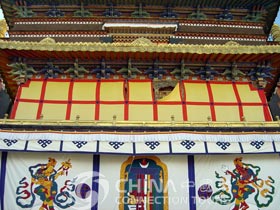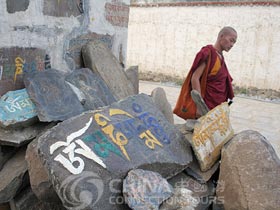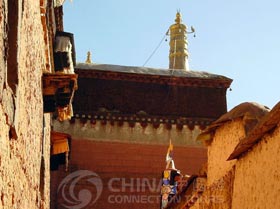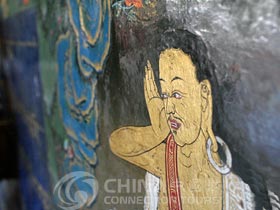 Built in 1447, the Tashilhungpo (meaning auspicious Sumeru) Monastery is located on the southern slope of the Nyima Mountain to the west of the Shigatze city. It is one of the four monasteries of the Gelug Sect of Tibetan Buddhism. According to historical documents, the monastery was built under the supervision of the first Dalai Lama, Genden Zhuba, a disciple of Zongkapa, the founder of the Yellow Sect. When the fourth Panchen Lobsan Qoigyi became the abbot, it was expanded to a large scale. Since then, the monastery has become the residence of Panchen Lama. Listed as a key relic under state protection by the State Council on March 4, 1961, the monastery occupies 150,000 square meters. Facing south, the complex is built symmetrically against the Nyima Mountain. Its wall, over 3,000 meters long and built according to the topography of the mountain, surrounds 57 buildings, and more than 3,600 rooms.
Built in 1447, the Tashilhungpo (meaning auspicious Sumeru) Monastery is located on the southern slope of the Nyima Mountain to the west of the Shigatze city. It is one of the four monasteries of the Gelug Sect of Tibetan Buddhism. According to historical documents, the monastery was built under the supervision of the first Dalai Lama, Genden Zhuba, a disciple of Zongkapa, the founder of the Yellow Sect. When the fourth Panchen Lobsan Qoigyi became the abbot, it was expanded to a large scale. Since then, the monastery has become the residence of Panchen Lama. Listed as a key relic under state protection by the State Council on March 4, 1961, the monastery occupies 150,000 square meters. Facing south, the complex is built symmetrically against the Nyima Mountain. Its wall, over 3,000 meters long and built according to the topography of the mountain, surrounds 57 buildings, and more than 3,600 rooms.
The earliest building in the monastery is the Coqen Hall (Large Scripture Hall), the construction of which took 12 years. Inside are 48 red pillars, which support the ceiling. In the center of the hall is the throne of the Panchen. To the left of the hall is the Great Buddha Hall, built in 1461 with financial support from Jorwo Zhabung, king of the Guge Kingdom in Ngari. Inside stands the 11-meter-tall, benevolent-looking Maitreya. To the right of the hall is the Tara Hall, which houses a two-meter-tall bronze statue of White Tara and two clay statues of Green Tara. The interior is decorated with schist collected at the foot of the Himalayas and radiates a peaceful aura.
 In front of the hall is a 600-square-meter area where the Panchen gives Buddhist lectures and lamas discuss Buddhist scriptures. On the surrounding stone walls are engravings of the images of the founder of Buddhism, the four Heavenly Kings, the 18 arhats and 1,000 statues of Buddha with different facial expressions. In the middle of the northern wall are engraved images of sages such as Zongkapa, the founder of the Yellow Sect, 80 senior monks and variously styled flying apsaras and Bodhisattva.
In front of the hall is a 600-square-meter area where the Panchen gives Buddhist lectures and lamas discuss Buddhist scriptures. On the surrounding stone walls are engravings of the images of the founder of Buddhism, the four Heavenly Kings, the 18 arhats and 1,000 statues of Buddha with different facial expressions. In the middle of the northern wall are engraved images of sages such as Zongkapa, the founder of the Yellow Sect, 80 senior monks and variously styled flying apsaras and Bodhisattva.
Gyinalhakang, the Han Chinese Buddhist Temple, houses many gifts to the Panchen from Chinese emperors of past dynasties, such as ancient porcelain, gold and silver goblets, tea sets, bowls and plates, jade containers and refined fabrics. The earliest objects, the nine bronze Buddha statues, are said to have been brought to Tibet by Princess Wencheng of the Tang Dynasty (AD 618-907). A red Tara bronze statue is believed to have been made in the Yuan Dynasty (1206-1368). A 16.5-jin gold seal, inscribed with the three languages of Chinese, Mongolian and Tibetan, is a gift from an emperor of the Qing Dynasty (1616-1911). There are also Buddhist beads made of precious stones, imperial mandates and Buddhist scriptures.
West of the Tashilhungpo Monastery is the Qamba Buddha Hall, which was built in 1914 under the supervision of the ninth Panchen, Qoigyi Nyima. The hall is 30 meters high and covers 862 square meters. In the hall, the bronze statue of Qamba Buddha is the tallest of its kind in the world. It took 110 workers four years to finish casting it. The statue used 6,700 taels of gold and 115,000-odd kilograms of copper. The statue sits on a 3.8-meter-high lotus seat. It is 26.2 meters high, his shoulder 11.5 meters wide, his foot 4.2 meters long, his hand 3.2 meters long, his middle finger 1.2 meters long and his ear 2.8 meters long. Between his eyes are inlaid a total of 1,400 pieces of diamond of various sizes, pearls, amber, coral and other precious stones.
 In 1985, the State Council allocated special funds to renovate the divine pagoda of the fifth to ninth Panchen Lamas, which had been destroyed during the 1966-1976 Cultural Revolution. Under the personal supervision of the 10th Panchen, the sacrificial hall built to the memory of past Panchen Lamas was named Tashinamgyi (Auspicious Heaven), which opened on January 22, 1989. The whole project lasted three years and eight months. Covering a floor space of 1,933 square meters, the hall is 33.17 meters high, inside which the divine pagoda is 11.52 meters high. The gilded pagoda is covered with a layer of silver and inlaid with precious stones in decorative patterns. The remains of Panchen Lamas in five sandalwood boxes are inside the pagoda. In its center is the bronze statue of the ninth Panchen, Qoigyi Nyima. The walls of the hall are decorated with murals depicting the contributions of famous lamas of different sects.
In 1985, the State Council allocated special funds to renovate the divine pagoda of the fifth to ninth Panchen Lamas, which had been destroyed during the 1966-1976 Cultural Revolution. Under the personal supervision of the 10th Panchen, the sacrificial hall built to the memory of past Panchen Lamas was named Tashinamgyi (Auspicious Heaven), which opened on January 22, 1989. The whole project lasted three years and eight months. Covering a floor space of 1,933 square meters, the hall is 33.17 meters high, inside which the divine pagoda is 11.52 meters high. The gilded pagoda is covered with a layer of silver and inlaid with precious stones in decorative patterns. The remains of Panchen Lamas in five sandalwood boxes are inside the pagoda. In its center is the bronze statue of the ninth Panchen, Qoigyi Nyima. The walls of the hall are decorated with murals depicting the contributions of famous lamas of different sects.
The 10th Panchen, Erdeni Qoigyi Gyaincain, passed away on an inspection tour of Shigatze on January 20, 1989. Three  days later, the State Council issued a decision to build a sacrificial hall to enshrine the body of the 10th Panchen. The state allocated 64.24 million yuan of special funds, and 614 kilograms of gold and 275 kilograms of silver to be used in building the hall. The project took three years. A grand inaugural ceremony was held on September 4, 1993 and the hall was named Shesongnamgyi, meaning sacrificial hall for the three sages of Paradise, Human World and Nether World. The naming itself was a serious matter. Four names were submitted, and each was wrapped inside a zanba in the shape of a ball. The four balls were put in a bottle before the body of the Panchen Lama. After three days of sutra chanting, a ball jumped out of the bottle when it was being shaken. Peeling off the zanba, the name appeared: Shesongnamgyi. The 35.25-meter-high sacrificial hall covers a floor space of 1,933 square meters, and its wall is 1.83 meters thick. The style of the building is at once traditional and modern, displaying both ethnic and religious features.
days later, the State Council issued a decision to build a sacrificial hall to enshrine the body of the 10th Panchen. The state allocated 64.24 million yuan of special funds, and 614 kilograms of gold and 275 kilograms of silver to be used in building the hall. The project took three years. A grand inaugural ceremony was held on September 4, 1993 and the hall was named Shesongnamgyi, meaning sacrificial hall for the three sages of Paradise, Human World and Nether World. The naming itself was a serious matter. Four names were submitted, and each was wrapped inside a zanba in the shape of a ball. The four balls were put in a bottle before the body of the Panchen Lama. After three days of sutra chanting, a ball jumped out of the bottle when it was being shaken. Peeling off the zanba, the name appeared: Shesongnamgyi. The 35.25-meter-high sacrificial hall covers a floor space of 1,933 square meters, and its wall is 1.83 meters thick. The style of the building is at once traditional and modern, displaying both ethnic and religious features.
 In August on the Tibetan calendar each year, lamas in the Tashilhungpo Monastery hold the Ximoqenpo Festival--the Holy Dance Festival. Originally it was a religious ritual to drive away evil spirits. On August 3 on the Tibetan calendar each year, a dance contest is held among lamas in the monastery, and the festival formally commences on August 4 and lasts three days till August 6, when it is open to the public. The monastery now boasts 39 lamas who can dance 61 different kinds of dances. A huge tent is set up on a platform. On its left are seats for distinguished guests; on its right is the orchestra of the monastery; and in front of the platform is the audience. The whole activity is imbued with a strong religious fervor and follows a strict protocol. The dance is simple in rhythm and slow in execution. To enliven the atmosphere, some short, light pieces are performed between the dances. During the three-day festival, dozens of holy dances are performed, such as Buddha's Warrior Attendant Dance, Skeleton Dance, Deer and Cow Dance, Bhiksu Dance and Six Longevity Dance.
In August on the Tibetan calendar each year, lamas in the Tashilhungpo Monastery hold the Ximoqenpo Festival--the Holy Dance Festival. Originally it was a religious ritual to drive away evil spirits. On August 3 on the Tibetan calendar each year, a dance contest is held among lamas in the monastery, and the festival formally commences on August 4 and lasts three days till August 6, when it is open to the public. The monastery now boasts 39 lamas who can dance 61 different kinds of dances. A huge tent is set up on a platform. On its left are seats for distinguished guests; on its right is the orchestra of the monastery; and in front of the platform is the audience. The whole activity is imbued with a strong religious fervor and follows a strict protocol. The dance is simple in rhythm and slow in execution. To enliven the atmosphere, some short, light pieces are performed between the dances. During the three-day festival, dozens of holy dances are performed, such as Buddha's Warrior Attendant Dance, Skeleton Dance, Deer and Cow Dance, Bhiksu Dance and Six Longevity Dance.

